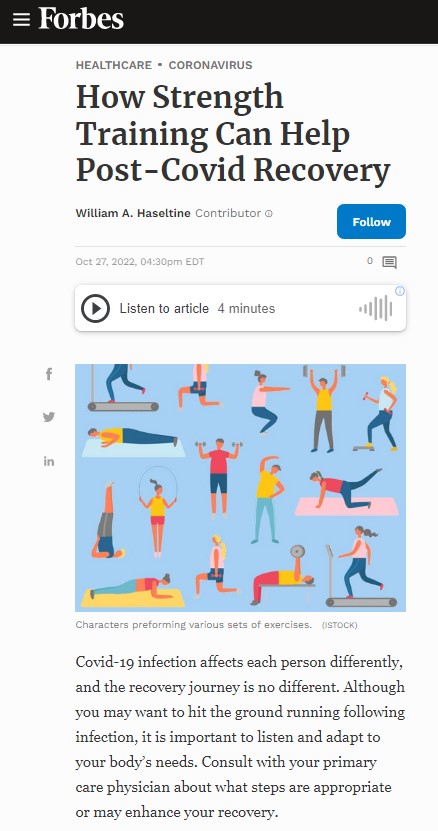How Strength Training Can Help Post-Covid Recovery
(Posted on Friday, October 28, 2022)

Covid-19 infection affects each person differently, and the recovery journey is no different. Although you may want to hit the ground running following infection, it is important to listen and adapt to your body’s needs. Consult with your primary care physician about what steps are appropriate or may enhance your recovery.
Resistance training has shown to be beneficial and a potentially interesting activity to consider. When done correctly, strength exercises improve mental and functional capacity across all age groups. Below, I highlight existing literature describing the benefits of strength training when done alone, or in a combination with aerobic exercise.
What We Already Know
A cannon of literature has demonstrated the health benefits of strength training, especially resistance exercise. In a meta-analysis studying participants who were healthy, “nonathletic,” and at least 18 years of age, researchers found resistance training helpful in reducing resting blood pressure, improving flow-mediated dilation (reducing the risk of poor cardiovascular outcomes), enhancing cardiorespiratory fitness, and favorable blood biomarkers (especially among older adults). In a separate literature review focusing on mental health benefits associated with strength training, researchers highlight how such exercises have consistently been associated with reduced anxiety symptoms, small to moderate improvements in cognition, positive changes in overall self-esteem and aspects of quality of life and mental health among healthy adults.
When done alone or in some combination with aerobic exercise, resistance exercise has also benefited muscle performance and general quality of life. In a study focusing on the effectiveness of implementing a telerehabilitation exercise program in primary care among patients previously infected with Covid-19, researchers found significant improvements in fatigue and dyspnea, as well as increases in muscle growth and handgrip strength when participants followed a mixed low-or-high intensity aerobic exercise with resistance training.
No Need For Fancy Equipment or a Gym Membership
Resistance training can be done in the comfort of your home or on the grass at a nearby park. A separate literature review highlighted how such exercises can be well adapted in many different environments! While single-joint exercises like quad extensions or biceps curl are found to make no significant impact on health, multi-joint exercises like squats and push-ups are said to produce sufficient muscle gain. In addition, stationary bike training, use of elastic bands, and plyometric training work well.
Listen To Your Body; No Size fits all Exercise Regimen Exists
Unlike aerobic exercise, resistance training requires less cardiovascular demand, which is a great benefit when resuming (or beginning) to exercise following infection or having to be done in a mask. When done properly, strength training is safe and feasible for all.
Short intervals of training periods can induce significant improvements in physical fitness among post-covid-19 patients. A growing number of studies have found exercise intensity ranging from 30 to 80% of 1RM for resistance exercises and from 3 to 5 on the modified Borg scale for aerobic exercise serve well to post-covid patients. Specifically, exercise programs based on a combination of low volume resistance exercises (e.g., 1–2 sets of 8–10 repetitions at 30–80% of 1RM) and aerobic exercise (e.g., 5 to 30 min at moderate intensity) may help on the road recovery for post-COVID-19 patients. The combination increases muscle strength, reduces activity-induced shortness of breath and fatigue, and perceptions of quality of life.
No individual is the same, however, especially when it comes to exercise. It is important to listen to your body’s needs and work at a sustainable pace. It may be wise to avoid high-intensity aerobic exercise and resistance training, or long sessions of exercise; such activities may induce immunosuppression and increase vulnerability to re-infection. Consult with your primary care provider about next steps to take on your recovery journey from Covid-19.
Read original article on Forbes.

